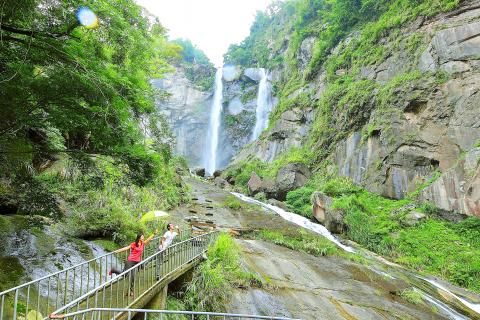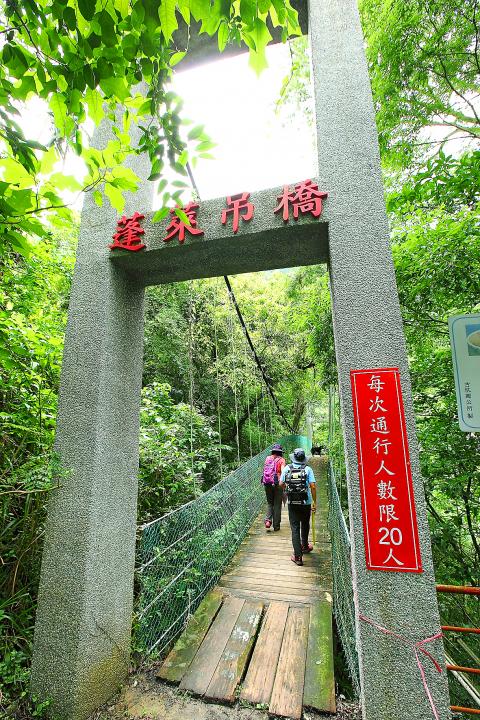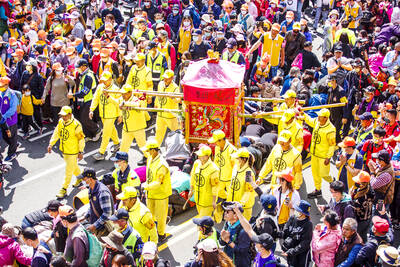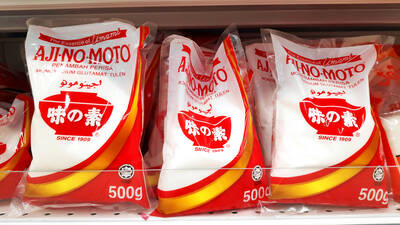Penglai Waterfall in Yunlin County’s Caoling is part of the Jhugao River in the Jhuoshuei River Basin. In the summer months, the river crashes 200 meters down from 1,200 meters above sea level, forming the majestic Penglai Waterfall among a rocky landscape. With the path to the waterfall even and pleasant to walk, lined with a wealth of flora and fauna and dispersed along the way with smaller waterfalls cascading down the cliffs and over caves and occasionally splashing you, it is perfect for a family outing in the cool air.
There is a brick paved path to Penglai Waterfall, and a five-minute stroll leads you over a small bridge and then across the Penglai suspension bridge. Here, the landscape changes to precipitous cliffs, and you can see the Jhugao River as it burbles by. To either side you will occasionally see small streams following the path of the river emerging from between the cliffs, sometimes forming mini waterfalls as the water cascades over boulders obstructing the flow of the river.
At this point the air will start to turn cooler, and you will see tadpoles and frogs in the pools to the sides of the path. Around five minutes past model dinosaurs is a balmy viewing platform affording views of the river down below. It is at the end of the path that you get a sense of the splendor of the Penglai Waterfall and the power of the water, with smaller waterfalls creating whirlpools in the river among the rocks.

Photo: Lee Hui-chou, Liberty Times
照片:自由時報記者李惠洲
(Liberty Times, translated by Paul Cooper)
雲林草嶺的蓬萊瀑布屬濁水溪流域的竹篙水溪,特殊的石壁地質景觀,使得夏季的溪水從海拔一千兩百公尺處垂降到一千公尺處,形成壯闊的蓬萊瀑布。前往瀑布的步道由於路線平整好走,沿途有眾多動植物生態可以近距離觀賞,且一路上小瀑布散布於石壁與山洞間,不時溪水飛濺,十分涼快,適合一家大小一起來。
蓬萊瀑布的步道鋪有石磚,行走約五分鐘,走上小橋再穿越蓬萊吊橋後,景色轉為石壁地形,可見竹篙水溪淙淙流水,兩旁不時可見流水從上游沿著河道與石壁中間竄出,溪水中的水流經過大石子的阻擋也成了小瀑布。

Photo: Lee Hui-chou, Liberty Times
照片:自由時報記者李惠洲
此區開始感覺到氣溫降低,路旁水坑也可見蝌蚪與青蛙;當經過了一恐龍造景約莫五分鐘後,即可來到觀賞平台,往下觀看溪中景致,如同處在天然的冷氣中,抵達步道終點,可感受到蓬萊瀑布的壯觀與水勢的磅礡,接續著的小瀑布也在石子形間成了漩渦。
(自由時報)

The Matsu pilgrimage is one of Taiwan’s most iconic annual religious events. This grand occasion is more than just a religious ceremony; it deeply reflects Taiwan’s history and culture. Originally, Matsu was the goddess of the sea, primarily responsible for protecting fishermen and ensuring their safe voyage. As immigrants brought Matsu worship to Taiwan, she gradually evolved into a deity overseeing health, business, and various aspects of life. In times of uncertainty, Matsu has become a vital source of spiritual comfort for the Taiwanese. The pilgrimage represents Matsu’s annual tour to inspect her domain, driving away evil and bringing

Monosodium glutamate (MSG) has been used in cooking for over a century to enhance flavor. It is often found in Chinese dishes and many other cuisines. Despite its common use, many people misunderstand the safety of MSG. The bad __1__ of MSG started in the late 1960s, when a letter to the New England Journal of Medicine described symptoms like a racing heart, weakness, and numbness after the writer ate Northern Chinese food. While no specific cause was __2__, a series of questionable studies in 1968 began to point the finger at MSG. In one such study, neurologist Herbert Schaumburg and

A: The World Expo 2025 is set to open in Osaka, Japan, on Sunday, with 158 countries and regions and nine international organizations participating in the event. B: Wow, what’s the theme this time? A: The theme is “Designing Future Society for Our Lives.” B: Do you want to go? How long will it last? A: It’ll run for 184 days, until Oct. 13. Maybe we can go to Osaka during summer vacation. A: 2025年世界博覽會預計週日將在日本大阪開幕,158個國家或地區及9大國際組織將參與盛會! B: 哇這次的主題是什麼? A: 主題是:「創造閃耀生命光輝的未來社會」。 B: 你想要去嗎?展出多久啊? A: 世博會共展出184天到10月13日,或許我們暑假時可以去大阪玩。 (By Eddy Chang, Taipei Times/台北時報張迪)

A: The World Expo 2025 is about to open in Osaka. Is Taiwan going to participate in the event too? B: Sure, the Taiwan External Trade Development Council (TAITRA) will launch a Taiwan pavilion named “Tech World.” A: That sounds cool, and it can showcase our national strength in technology. B: The theme is “Connecting the world to create better future lives together.” The pavilion aims to attract over one million visitors. A: I hope humans can really create better future lives through this year’s fair. A: 2025年世博會即將開幕,這次台灣也會參加嗎? B: 當然啦,外貿協會的台灣館將以「Tech World」名義參展! A: 聽起來蠻酷的,應該是想強調台灣的科技實力。 B: 策展主題則是:「連結世界,共創未來美好生活」,希望能吸引到100萬人次參訪。 A: 希望藉由這次世博會,人類真的能共創美好生活。 (By Eddy Chang, Taipei Times/台北時報張迪)